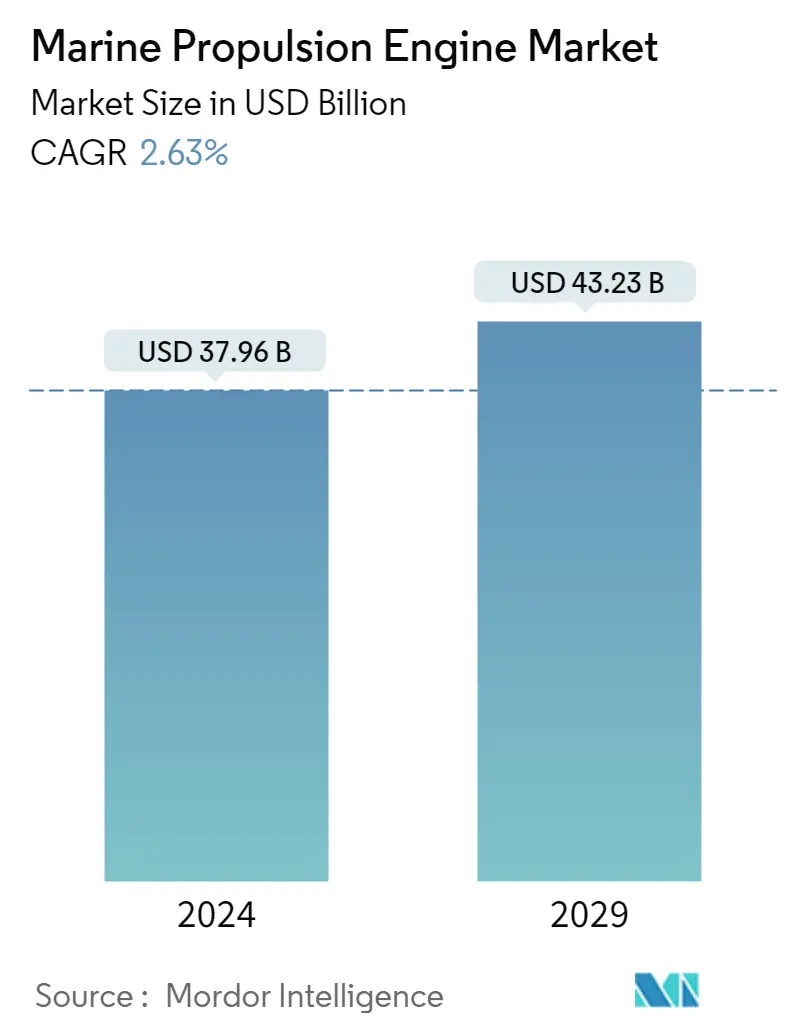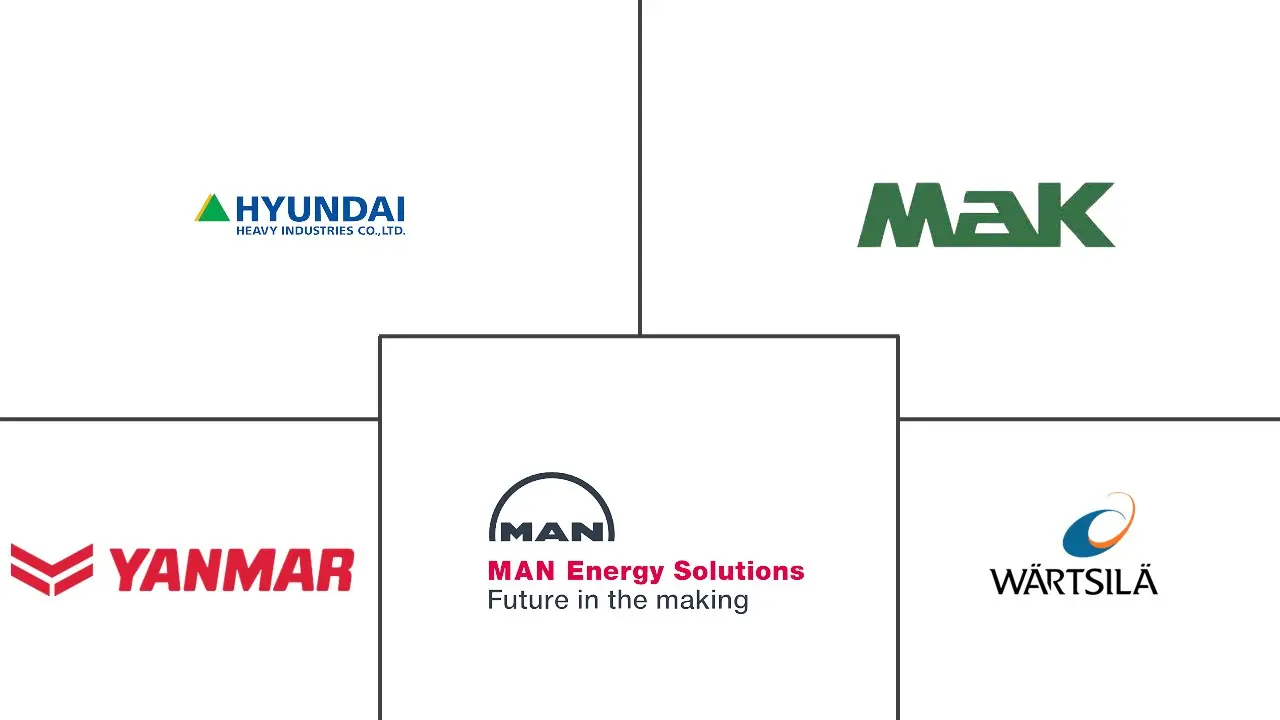Market Size of Marine Propulsion Engine Industry

| Study Period | 2019 - 2029 |
| Market Size (2024) | USD 37.96 Billion |
| Market Size (2029) | USD 43.23 Billion |
| CAGR (2024 - 2029) | 2.63 % |
| Fastest Growing Market | Asia-Pacific |
| Largest Market | Asia-Pacific |
| Market Concentration | Medium |
Major Players
*Disclaimer: Major Players sorted in no particular order |
Marine Propulsion Engine Market Analysis
The Marine Propulsion Engine Market size is estimated at USD 37.96 billion in 2024, and is expected to reach USD 43.23 billion by 2029, growing at a CAGR of 2.63% during the forecast period (2024-2029).
The COVID-19 outbreak hindered the growth of the marine propulsion engine market with continuous lockdowns and the subsequent economic slowdown across the world. Marine mobility declined by 13.77% during the COVID-19 pandemic across the world. The ships were stranded in the waters as they were not allowed to enter the ports and the shipping companies had to bear additional costs to keep their ships stranded in international waters. In 2020, the traveling restrictions also led to a decline of 42.77% in the cruise industry across the world. Such factors led to a huge drop in the demand for new ships, adversely impacting the shipbuilding and marine propulsion engine markets. The most significant near-term impact on marine engines was felt through supply chains. However, post-pandemic, as restrictions are beginning to ease, the market is expected to gain momentum during the forecast period.
- In June 2020, Hyundai Heavy Industries merged its shipbuilding and offshore businesses into a single entity to mitigate the impact of COVID 19.
The marine propulsion engine market is driven by the need for faster, cleaner, and fuel-efficient engines. The International Maritime Organization (IMO) drafted a new rule where the sulfur content in marine fuel will be reduced to 0.5% from 3.5%. This new regulation is expected to cut down emissions from ships by 77%. This development has caused the ship operators to lower sulfur content fuels, such as marine gas oil, thus driving the demand for the electrification of marine vessels.
The Asia-Pacific region is anticipated to observe rapid growth over the forecast period due to augmented international trade and export from the region. Both India and China have come up as major hubs of business in the region, with an increased pace of activities in the marine manufacturing sector and maritime trade due to the presence of ports like Shanghai, Hong Kong, Nhava Shava (India), and Singapore. Growth in the Asia-Pacific market will also be driven by new technology developmnets by key players.
- In September 2022, the Ministry of Oceans and Fisheries of South Korea awarded Daewoo Shipbuilding & Marine Engineering to build the country's first hydrogen powered tug boat by 2026, as a part of the country's efforts to develop eco-friendly, high value ships.
Thus, the aforementioned factors are projected to produce a decent growth in the marine propulsion engine market over the next five years.
Marine Propulsion Engine Industry Segmentation
Marine propulsion is the system or mechanism used to generate thrust that allows a small boat or even a ship to move across waterways. Modern ships are usually equipped with mechanical systems consisting of an electric motor turning a propeller or even pump-jets or an impeller. They use reciprocating engines as the main source of power.
The market is segmented by engine type, application type, ship type, and geography. By engine type, the market is segmented into diesel, gas turbine, natural engine, and other engine types. By application type, the market is segmented into passenger, commercial, and defense. By ship type, the market is segmented into container ships, tankers, bulk carriers, offshore vessels, naval ships, and passenger ships. By geography, the market is segmented into North America, Europe, Asia-Pacific, and the Rest of the World.
| Engine Type | |
| Diesel | |
| Gas Turbine | |
| Natural Engine | |
| Other Engine Types |
| Application Type | |
| Passenger | |
| Commercial | |
| Defense |
| Ship Type | |
| Container Ship | |
| Tanker | |
| Bulk Carrier | |
| Offshore Vessel | |
| Naval Ship | |
| Passenger Ship |
| Geography | |||||||
| |||||||
| |||||||
| |||||||
|
Marine Propulsion Engine Market Size Summary
The marine propulsion engine market is poised for growth over the forecast period, driven by the increasing demand for faster, cleaner, and more fuel-efficient engines. The market experienced a setback during the COVID-19 pandemic due to lockdowns and economic slowdowns, which led to a decline in marine mobility and a significant drop in the demand for new ships. However, as restrictions ease, the market is expected to regain momentum. The International Maritime Organization's new regulations aimed at reducing sulfur content in marine fuel are pushing ship operators towards electrification and cleaner fuel alternatives, further driving market demand. The Asia-Pacific region is anticipated to witness rapid growth, supported by robust international trade, advancements in marine manufacturing, and the presence of major shipping hubs and companies.
The market is moderately consolidated, with key players like MAN Energy Solutions SE, Wartsila Corporation, and Hyundai Heavy Industries Co. Ltd. focusing on innovation and sustainability to capture market share. The region's dominance is reinforced by stringent emission regulations, prompting the development of engines that meet these standards. Collaborations and new product launches, such as Volvo Penta's dual-fuel hydrogen-powered solutions and MAN Energy Solutions' methanol-powered engines, are indicative of the industry's shift towards eco-friendly technologies. The increasing orders for LNG carriers and the development of hydrogen-powered vessels highlight the market's transition towards sustainable maritime transportation solutions. These factors collectively contribute to the expected growth and evolution of the marine propulsion engine market in the coming years.
Marine Propulsion Engine Market Size - Table of Contents
-
1. MARKET DYNAMICS
-
1.1 Market Drivers
-
1.2 Market Restraints
-
1.3 Industry Attractiveness - Porter's Five Forces Analysis
-
1.3.1 Bargaining Power of Suppliers
-
1.3.2 Bargaining Power of Consumers
-
1.3.3 Threat of New Entrants
-
1.3.4 Threat of Substitute Products
-
1.3.5 Intensity of Competitive Rivalry
-
-
-
2. MARKET SEGMENTATION
-
2.1 Engine Type
-
2.1.1 Diesel
-
2.1.2 Gas Turbine
-
2.1.3 Natural Engine
-
2.1.4 Other Engine Types
-
-
2.2 Application Type
-
2.2.1 Passenger
-
2.2.2 Commercial
-
2.2.3 Defense
-
-
2.3 Ship Type
-
2.3.1 Container Ship
-
2.3.2 Tanker
-
2.3.3 Bulk Carrier
-
2.3.4 Offshore Vessel
-
2.3.5 Naval Ship
-
2.3.6 Passenger Ship
-
-
2.4 Geography
-
2.4.1 North America
-
2.4.1.1 United States
-
2.4.1.2 Canada
-
2.4.1.3 Rest of North America
-
-
2.4.2 Europe
-
2.4.2.1 Germany
-
2.4.2.2 United Kingdom
-
2.4.2.3 France
-
2.4.2.4 Spain
-
2.4.2.5 Rest of Europe
-
-
2.4.3 Asia-Pacific
-
2.4.3.1 China
-
2.4.3.2 Japan
-
2.4.3.3 India
-
2.4.3.4 South Korea
-
2.4.3.5 Rest of Asia-Pacific
-
-
2.4.4 Rest of the World
-
2.4.4.1 Brazil
-
2.4.4.2 Other Countries
-
-
-
Marine Propulsion Engine Market Size FAQs
How big is the Marine Propulsion Engine Market?
The Marine Propulsion Engine Market size is expected to reach USD 37.96 billion in 2024 and grow at a CAGR of 2.63% to reach USD 43.23 billion by 2029.
What is the current Marine Propulsion Engine Market size?
In 2024, the Marine Propulsion Engine Market size is expected to reach USD 37.96 billion.

